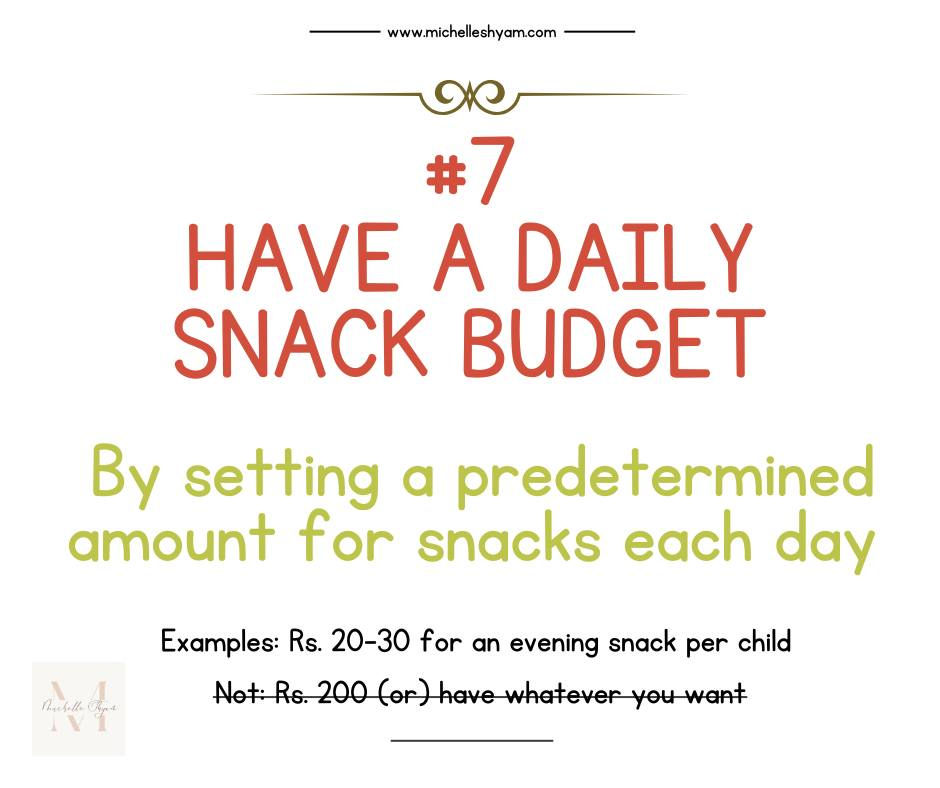Nutrition Nudges For Teens
- Michelle Shyam

- Oct 13
- 9 min read
Raising teens in today’s snack-loaded world can feel like navigating a supermarket maze blindfolded. These 8 simple nutrition tips are your compass to help your growing kids (and you!) make smarter, more mindful food choices.

Keep it simple:
Opt for snacks with fewer than four ingredients to avoid unnecessary additives and preservatives.

Several common snacks may contain additives and preservatives that are considered less healthy. It's essential to be aware of these ingredients and make informed choices. Here are some harmful additives and preservatives commonly found in snacks:
Artificial Colors (e.g., Red 40, Yellow 5, Blue 1): Found in: Candies, flavored snacks, cereals
Concerns: Linked to hyperactivity in some children; potential carcinogenic effects
High-Fructose Corn Syrup (HFCS): Found in: Sweetened beverages, processed snacks, candies
Concerns: Associated with obesity, type 2 diabetes, Insulin Resistance
Artificial Sweeteners (e.g., Aspartame, Sucralose): Found in: Sugar-free snacks, diet sodas, sugar-free gum
Concerns: Potential laxative effect for children; some studies suggest links to health issues, while others dispute these claims
Partially Hydrogenated Oils (Trans Fats): Found in: Processed baked goods, fried snacks (muruku, chips, sev, fryams)
Concerns: Raises VLDL cholesterol, increases the risk of heart disease
Monosodium Glutamate (MSG): Found in: Processed and savory snacks, some Chinese foods
Concerns: May cause headaches, nausea, and other symptoms in sensitive kids
Sodium Nitrate and Nitrite: Found in: Processed meats (e.g., hot dogs, bacon)
Concerns: Linked to an increased risk of certain cancers, particularly when consumed in large amounts
BHA (Butylated Hydroxyanisole) and BHT (Butylated Hydroxytoluene): Found in: Cereals, chewing gum
Concerns: Potential carcinogens, with some studies suggesting links to cancer
Potassium Bromate: Found in: Some baked goods, bread, pizza base
Concerns: May be carcinogenic; banned in several countries but not universally prohibited
Propyl Gallate: Found in: Processed meats, some snack foods
Concerns: Linked to potential health risks; some studies indicate possible carcinogenic effects. Note: Chewing gum may sometimes contain propyl gallate as an antioxidant.
Sulfites: Found in: Dried fruits, wine, some snack foods (chips, crackers)
Concerns: Can cause allergic reactions in some individuals, particularly those with asthma
Pronounceable rule:
If you can't pronounce the ingredients, reconsider the snack choice. Choose foods with recognizable, real ingredients for better nutritional value.

Here are examples of snacks with ingredients that might be more challenging to pronounce or less recognizable:
Artificially Flavored Fruit Snacks: Ingredients: Methylcellulose, sodium benzoate.
Processed Cheese and Crackers: Ingredients: Sodium stearoyl lactylate, sorbic acid, mono and diglycerides.
Microwaveable Popcorn with Artificial Butter Flavor: Ingredients: Diacetyl, hydrogenated soybean oil, Tert-Butylhydroquinone
Flavored Potato Chips: Ingredients: Disodium inosinate, maltodextrin, autolyzed yeast extract.
Energy Drinks: Ingredients: Taurine, guarana extract, sodium benzoate.
Protein Bars with Artificial Sweeteners: Ingredients: Sucralose, acesulfame potassium, soy lecithin.
Note for the kids: Remember, the presence of these ingredients doesn't necessarily mean a product is unhealthy, but if you encounter unfamiliar ingredients, it's a good idea to research them!
Mind the sugar:
Aim for snacks with less than 5g of added sugar.
Added sugars are sugars that are added to food during processing or preparation. They are different from the natural sugars found in whole foods like fruits and dairy products. Look for the "Added Sugars" section on the label to determine how much sugar has been added to the product.

The American Heart Association (wasn't able to find Indian recommendation) recommends that teens limit their daily added sugar intake to no more than 25 grams (about 6 teaspoons) for females and 38 grams (about 9 teaspoons) for males in a day. Keeping snacks within the 5g limit aligns with these guidelines, assuming teens are having added sugar in their meals, morning and evening beverage (milk with sugar, hot chocolate, Boost) etc.
Snacks with 5g or More Added Sugar:
Indian Snacks:
Packaged Sweets: Many packaged traditional Indian sweets, like Gulab Jamun or Rasgulla, can contain more than 5g of added sugar per serving.
Sweetened Yogurt: Flavored yogurts with added fruits or sweeteners can have higher sugar content.
Flavored Lassi: Some commercially available flavored lassi drinks or rose milk can contain added sugars surpassing 5g per serving.
Sweetened Namkeen (Savory Snacks): Certain packaged savory snacks may have added sugars, especially if they have sweet or tangy coatings.
Western Snacks:
Granola Bars: Some commercially available granola bars can have added sugars exceeding 5g per bar.
Flavored Yogurt: Fruit-flavored yogurts, especially those in single-serving containers.
Sweetened Dried Mix: Some pre-packaged nut mixes with added dried fruits or sweet coatings can exceed 5g of added sugar.
Packaged Muffins and Brownies: Pre-packaged muffins, especially those with fruit fillings or toppings, may have higher levels of added sugar. Other examples are commercially produced cookies, especially those with added chocolate chips, icing.
Snacks with Lesser Than 5g of Added Sugar:
Indian Snacks:
Plain Roasted Nus: Unsalted and unflavored roasted nuts typically contain minimal added sugar.
Masala Puffed Rice (Murmura): A savory snack with spices and minimal added sugars.
Khakra: Plain khakra, a thin cracker-like Indian bread, often has little to no added sugar.
Western Snacks:
Plain Greek Yogurt: Unsweetened Greek yogurt with no added flavors or sweeteners.
Air-Popped Popcorn: Plain popcorn without sugary coatings or flavorings
Whole Grain Crackers: Crackers made with whole grains and minimal added flavorings often have less than 5g of added sugar.
Create snack zones:
Designate specific areas in your living space as "snack zones." This helps avoid continuous grazing and encourages intentional snacking during designated times.

Define Snack Zones: Designate specific areas such as the kitchen counter, dining table, or balcony as snack zones. These areas are dedicated to consuming snacks, creating a clear distinction from other spaces in your home.
Encourage Family Involvement: Involve the entire family (you included!) in the creation of snack zones. Collaboratively decide on the designated areas and establish guidelines for snacking within those spaces. This fosters a sense of shared responsibility and commitment to healthy snacking habits.
Time-Based Snacking: Associate specific times with snack zones. For instance, encourage snacking during scheduled breaks or after school. This helps regulate eating patterns and prevents constant grazing throughout the day.
Minimize Distractions: Design snack zones to minimize distractions. Discourage the use of electronic devices or watching TV while snacking. Creating a calm and focused environment allows teens (and younger kids) to be more aware of their eating habits and enjoy their snacks mindfully.
Regular Snack Ritual: Incorporate a regular clean-up routine for the snack zone. Encourage everyone to tidy up after themselves, disposing of empty wrappers and ensuring the area remains inviting and clutter-free. Maintain this ritual for your own sanity sake!
Have a weekly snack plan:
To reduce impulse purchases and ensure variety with balanced macronutrients have a weekly snack plan.

Meal and Snack Scheduling: Begin by scheduling regular meal and snack times throughout the week. Determine the number of snacks needed each day, keeping in mind the nutritional requirements of all family members, their ages, especially teenagers with growing bodies. For example:
Morning Snack: Fresh fruit or Dairy (milk, curd, cheese)
Afternoon Snack: Yogurt with Khakra
Evening Snack: Egg sandwiches
Family Input and Preferences: Involve the entire family, especially teenagers, in the planning process. Discuss individual preferences, dietary restrictions, and snack ideas. This collaborative approach ensures that everyone's tastes and nutritional needs are considered. For example:
Family Fruit Salad: A mix of favorite fruits for the youngest.
DIY Trail Mix Bar: Assorted nuts, seeds, and dried fruits for the middle child.
Indian Snacks: Chikki variety for the oldest.
Theme Days: Make snack planning more engaging by incorporating themes. For example, designate a day for smoothie snacks, a day for savory snacks, a day for nut-based snacks, and a day for fruit-focused snacks. This adds variety and excitement to the weekly plan. Note: This way you can space out the "bad snacks" till you eventually phase them out completely! For example:
Monday Munchies - finger foods that are crunchy
Fried Fridays - Healthy savories or fried cutlets
Salad Saturdays - Vegetable or fruit salad of the child's choice
Smart Grocery Shopping: Create a comprehensive shopping list based on the weekly snack plan. This list should include all the ingredients needed for snacks and meals, reducing the likelihood of impulse purchases and ensuring you have everything on hand. Resist the urge to deviate from the agreed-upon snack plan. Do not be swayed by discounts in the "Biscuit Aisle". For example:
Buy 3 get 2 free - Milk Bikis
Buy 100g get 50g extra - Pringles
Nutrient-Dense Options: Prioritize nutrient-dense snack options over processed and sugary alternatives. Include a variety of whole foods such as fruits, vegetables, nuts, seeds, and dairy or dairy alternatives. For example:
Nutritious Options four times a week: Fresh fruits, vegetables, whole grain breads, lean proteins, dairy, nuts
Treats in Moderation twice a week: Chocolate, Chikkis, Pop-corn, Baked Makhana, Banana chips
Crap once a week: Ice-cream, Lollipop, Dough nuts
Rotate Snack Choices: Keep the snack plan dynamic by rotating snack choices regularly. Introduce new recipes, flavors, and textures to prevent boredom and cater to changing preferences. For example:
Nuts variety - cashew, almonds, pistachios, peanuts
Air-fried popcorn - cheese flavor, salted butter, jalapeno flavor, caramel, etc
Dairy variety - cheddar cheese cubes, crumbled feta and fruit, toasted paneer bites, mozzarella cheese toast
Repurpose leftovers:
By utilizing meal leftovers to make creative snacks.

Repurposing leftovers offers several benefits, both practical and environmental, making it a smart and sustainable approach to managing food. Here are some advantages:
Reducing Food Waste: Repurposing leftovers ensures that edible food items are utilized instead of being discarded.
Cost Savings: Creating new meals or snacks from leftovers helps stretch your food budget.
Time Efficiency: Utilizing leftovers often involves less preparation time since the main components are already cooked.
Creativity in the Kitchen: It challenges teens to think outside the box and come up with inventive ways to transform existing dishes into new, flavorful creations.
Enhancing Food Appreciation: It encourages teens (grown kids) to recognize the effort and resources that go into food production and preparation, promoting a more mindful and grateful attitude toward meals.
Here are some ideas of what you can do with leftover meals:
Leftover Vegetable Biryani Patties: Use leftover vegetable biryani or pulao. Shape the rice mixture into small patties. Pan-fry the patties until they develop a golden brown crust.
Leftover Chicken Curry Paratha Rolls: Take leftover chicken curry and shred the chicken. Warm up whole wheat parathas or bread slices. Spread a layer of the shredded chicken curry on the paratha/bread. Roll it up into a wrap or add another slice of bread on top.
Spaghetti Frittata: Mix leftover spaghetti with beaten eggs and grated cheese. Pour the mixture into a pan and cook until set. Slice into wedges for a delicious spaghetti frittata.
Caprese Bruschetta: Use leftover Caprese salad ingredients – tomatoes, mozzarella, and basil. Dice the tomatoes and mozzarella, mix with fresh basil, and season. Spoon the mixture onto toasted baguette slices for a refreshing bruschetta.
Leftover Dal Pancakes: Mix leftover dal (lentil curry) with chickpea flour, chopped onions, and spices. Form the mixture into small pancakes and pan-fry until golden brown. Serve with a side of mint chutney.
Have a daily snack budget:
By setting a predetermined limit on the amount of money allocated for snacks each day.

This practice can be beneficial for both financial planning and promoting responsible eating habits.
Financial Responsibility: They learn the value of money and the importance of making thoughtful choices within a defined budget. Allowing your teen to manage their snack budget fosters a sense of independence and autonomy.
Budgeting Skills: They learn to prioritize and allocate funds wisely, skills that are valuable for future financial independence. Example: Discuss with your teen how spending Rs. 100 in one evening on donuts is money taken away from tomorrow's snack allowance!
Understanding Costs: A daily snack budget encourages teens to understand the costs associated with snacks. They become more conscious of how different choices can impact their budget. Example: Compare the cost of purchasing a bag of chips to making popcorn at home.
Avoiding Impulse Purchases: Having a set daily budget discourages impulsive snack purchases. Older teens are more likely to think through their choices and resist the temptation to buy snacks on a whim.
Teaching Moderation: The budgeting concept teaches the importance of moderation. Your teen learns to enjoy snacks in reasonable quantities rather than excessive consumption. Example - one small scoop of ice-cream instead of a tub of ice-cream.
Flexibility within Limits: While there's a set budget, there can also be flexibility. Encourage your teen to explore creative ways to stretch their budget, such as choosing cost-effective yet nutritious homemade snacks. Example: Home-made cheese and chicken sandwich (provided ingredients are already available at home) versus Mc.Donald's burger.
No snack after dinner:
To discourage mindless nighttime grazing.

Reasons for No Snack After Dinner: Promotes Better Sleep: Eating close to bedtime can disrupt the body's natural sleep-wake cycle. Digesting food requires energy, and a heavy meal or snack may interfere with the body's ability to wind down for restful sleep.
Prevents Overconsumption: Evening snacks, especially if not chosen mindfully, can contribute to excess calorie intake. Avoiding snacks after dinner helps in controlling overall daily caloric consumption.
Encourages Mindful Eating: By establishing a cutoff time for snacking, teens are encouraged to be more mindful of their hunger and satiety cues during the evening hours.
Tips for Implementation: Establish a Cut-Off Time: Set a specific time after which the kitchen is closed for the night. This might be an hour or two before bedtime. Encourage family members, including teens, to adhere to this cut-off time.
Hydrate Instead: Staying hydrated is important, and it can also help curb unnecessary snacking.
Plan Balanced Dinners: Ensure that dinners are well-balanced and include a mix of protein, healthy fats, and complex carbohydrates (for teens). A satisfying and nutrient-rich dinner reduces the likelihood of feeling overly hungry later in the night.
Brush Teeth Early: Encourage the habit of brushing teeth earlier in the night. This serves as a signal that eating is finished for the night.
Listen to Hunger Signals: Teach teens to pay attention to their bodies and differentiate between physical hunger and emotional or boredom-driven cravings. If hunger persists after dinner, consider having eggs in any form (this could be the case on exam days)
Create a Supportive Environment: Foster an environment that supports the "No snack after dinner" rule by minimizing the availability of tempting snacks in the kitchen after dinner.
Small, consistent choices made today can shape your teen’s lifelong relationship with food. Start with these simple habits — they don’t just build healthier plates, they build healthier mindsets.




Comments